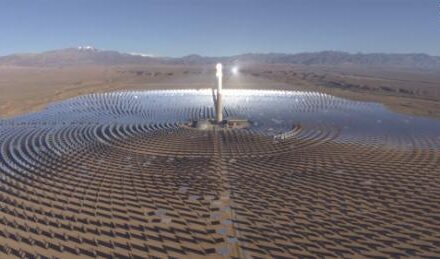This is another diary in the continuing “New Environmentalism” series. In this series, we’re going to be looking at ways to change the way we live and work – sometimes significantly – in order to live in harmony with our environment.
Goals of the New Environmentalism: devise a practical, realistic vision for a sustainable future and a plan for moving from our modern society to a sustainable society. In this society, we claim that the proper goal of economic activity is not growth but, rather, human happiness.
Knoxville Progressive and I encourage you to contact either of us by email if you’d like to be a contributor to this series (post a diary / host a discussion).
In one of the first diaries in the series, we looked at short-range transportation within a city. We saw that this could be managed without automobiles (though further reading has shown that biodiesel-powered busses are more feasible than I thought at the time) through a well-constructed public transit network. Now we’re going to look at long-distance movement, both of goods and people.
The Way We Do Things Now
Like our short-range transportation, modern long-range transportation is very reliant on cheap oil. Both the United States and Canada are webbed with a massive continental highway system. Jet airliners gulp down massive amounts of fuel as they race between major cities with humans crammed into uncomfortable seats. Massive cargo vessels move shipping containers between ports. Diesel locomotives haul long trains of containers from said ports to their final destinations.
Once again, we see the same factors at work: a reliance on cheap, high-pollution energy; an unseemly obsession with speed over comfort or safety; and transportation over unnecessarily long distances. With the age of cheap oil drawing to a close, things are obviously going to have to change. But how?
Terrestrial Transportation
Most inter-city transportation is best accomplished by sticking solidly to the ground. While it may be slower than flying, it’s also cheaper and less polluting and disruptive. We can manage this without recourse to highways by using the same methods our not-so-distant ancestors relied on: trains!
While they’ve fallen out of fashion in North America of late, other countries still have functional and modern rail networks. France and Japan immediately spring to mind, and are the countries with the most famous high-speed rail networks, but Italy, Spain, Germany, and South Korea also have extensive high-speed rail networks. For the purposes of this article, I’ll be focusing on the Japanese Shinkansen and the French TGV, as they’re the ones I’m the most familiar with.
Instead of the diesel locomotives common in North America, both the Shinkansen and the TGV are electrified – like metros, the locomotives draw their power from an external electric grid, rather than generating their own power. This has the same advantages as it does for the metro. Not only can the trains travel more quickly and more efficiently, as they don’t have to carry fuel with them and can have lighter engines, but there’s greater freedom in the methods used to generate the electricity. This makes these trains a very good match for green energy initiatives.
Safety on both lines is very high. The Shinkansen has never been the cause of a fatality since it began operating in 1964. Even the massive October 2004 earthquake did not even cause any injuries when it derailed a train near the epicentre of the quake! The TGV has a similarly impressive service record, and TGV trains have even derailed without harm to passengers thanks to their rigid construction. This record is significantly better than both automobiles and airplanes, and given the volume of traffic that both lines service, there is no reason that similar arrangements elsewhere in the world could not have similarly impressive safety records with appropriate time and money investments.
Trains have several other major advantages over air travel. Air travel is generally non-stop, because landings are time-consuming. Trains can have many stops along their routes without significantly increasing their travel time. They can also be much more comfortable. While space and weight are at a premium on airliners, trains are more flexible in this regard. The Shinkansen, for example, has cabins similar in design to airliners, even down to the seat designs, to allow it to transport as many people as possible. Even here, though, we can see some differences – larger windows, for example, or more visually interesting cabin designs. The TGV, on the other hand, has both airline-style seating and more traditional railway cabin-style. Most TGV trains also have a bar carriage. Trains can also remain linked into information networks throughout the course of their journey, making rapid travel slightly less of a necessity.
While I’ve focused on high-speed trains so far, not all train service needs to be high-speed. Slower trains, while less convenient, may have other advantages, including reduced cost of operation, simpler engineering, further improved safety, reduced environmental footprint, and increased passenger comfort. This isn’t a fundamental problem, but one of engineering and economics – which solution is best-suited for the circumstances and resources of a particular area.
One disadvantage of passenger rail over highways is that commuters lose some of the freedom of automobiles. This makes accessing smaller rural communities, which are unlikely to lie on or rate a full rail line, more difficult. The solution to this is smaller branch lines, using Dayliners or DMUs. Dayliner/DMU lines can run from regional hubs to rural town/village centres, from which residents and visitors can use more conventional automobile-style transport. (Presumably biodiesel powered) While the existing models I’ve linked above are diesel-powered, there’s no reason why these branch lines can’t draw off an electrical grid like the “arterial” high-speed trains.
Sailing the Ocean Blue
Ocean passenger service has diminished in favour of air travel, but ocean cargo service is still going as strong as ever. And, unfortunately, as dirty as ever. Emission standards for the diesel engines used in oceangoing vessels are lower even than those for cars and trucks. Combined with the rising cost of oil, this creates a serious problem.
Unlike land transportation, there’s no real easy solution here. hybrid vehicles, combining advanced “sail” designs with diesel engines, can save up to 27% of the fuel consumption on North Atlantic runs. Unfortunately, these ships are much less effective on runs in the Indian Ocean, and actually use more fuel than a more conventional design due to lower wind speed. The engineers producing them are also looking at other designs with improved fuel economy. Some achieve it by running at lower speeds, but these are only suitable for non-time-critical cargoes, a mere 20% of all cargoes worldwide.
For oceangoing cargo transportation, we may simply have to accept that the days of cheap, fast, high-volume transportation are over. I’ll say more about this in coming sections. There seems to me to be some potential for cargo ships using solar-powered or battery-powered electric engines, but I doubt they would be viable for long-distance, high-volume, or high-speed routes. Purely wind-powered vessels may be viable, but would probably be much slower than the alternatives. One interesting possibility is nuclear-powered vessels. While not economically viable historically, modern reactor designs combined with the rising price of oil may change that. Of course, this puts even more strain on the limited supply of economically viable sources of nuclear fissionables…
Passenger shipping has been largely dead since the 1960s, when it was supplanted by aircraft. If the propulsion problem can be solved, passenger shipping may be worth reviving for slower intercontinental journeys. Passengers would probably be able to travel in relative comfort, and the ships should be able to be designed for comfort without being overly luxurious, thus remaining affordable. Ocean liners, like trains, can be tied into a global information network more easily than aircraft and cars, making these long trips more tolerable.
Flying Through the Sky
Even though jet airliners are only economical because of cheap oil, the end of cheap oil doesn’t mean that we have to abandon air travel. Short-range fuel cell-powered aircraft will probably still be useful for emergencies. For real transportation, we may have to resurrect another of the favourites of a bygone age: the zeppelin! Back in the early 20th century, zeppelins were the method of choice for travelling quickly and in style. They could make intercontinental flights faster than ocean liners, and could carry reasonable amounts of cargo (mostly mail) in addition to their passengers.
The end of the zeppelin age came for two reasons. The first was the rise of cheaper, faster (but less comfortable) powered flight. The second was the Hindenburg disaster. While the final causes are disputed by some, and attempted investigations have proved inconclusive, it’s fairly certain that hydrogen zeppelins are a bad idea. Fortunately, helium works perfectly well, and is much safer.
Because jet airliners are still so cheap to operate, no company has attempted to build a large scale, long-range passenger zeppelin with modern technology. Several smaller ones have been constructed, such as the NT-7, a small zeppelin design produced by the German Zeppelin Company. It caps out at 12 passengers and two crew, but it’s still an impressive piece of engineering.
Green zeppelin designs seem to have a lot of potential. Their lighter-than-air construction means that, even fully loaded, it takes very little energy to keep them in the air. (Though most do need to use their engines to stay airborne when fully loaded) The upper hull of the zeppelin also has a large surface area that is almost constantly exposed to sunlight, and so might be profitably coated with solar panels. Although trips would be longer, passenger accommodations would probably be more comfortable than those on modern airliners.
Like ships and trains, zeppelins have a major advantage over modern air transport in that they can be tied into an information network more easily, due to their lower speed.
Avoiding Transportation
The final note I want to hit in this diary: the end of the era of cheap oil means we’re going to have to change the way we use transportation. Right now, we use it somewhat wastefully. Corporate executives and businessmen hop about on airplanes, travelling between face-to-face meetings. Corporations spread their activities out over the world to take advantage of cheap labour, and use cheap transportation to move goods (and executives) between installations.
Much of this is going to have to change. More manufacturing and processing is going to have to be done at the local level, using as many local resources as possible. This means that local operations are going to have to diversify again. Most trade will probably be in raw (or recycled) materials and other non-time-sensitive bulk goods, which can afford to take a while to get where they’re going.
For people, we’re just going to have to get used to moving around less. Vacations, moving, and trips to visit family will probably still be economical. The current “business” travel model is probably not sustainable. It’s also not necessary. Modern advances in information technology allow for cheap, effective teleconferencing. Apple’s iSight/iChat is the only one I have experience with, but other projects are in the works. GAIM, the excellent open source IM application, is working on adding video and voice support, and expects to have a working implementation in the near future.

This
work is licensed under a Creative
Commons Attribution-NonCommercial-ShareAlike 2.5
License.






